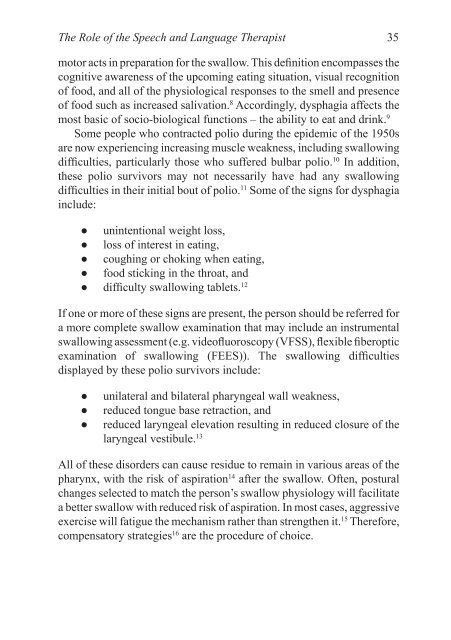Post Polio Syndrome - Management & Treatment in Primary
Post Polio Syndrome - Management & Treatment in Primary
Post Polio Syndrome - Management & Treatment in Primary
Create successful ePaper yourself
Turn your PDF publications into a flip-book with our unique Google optimized e-Paper software.
The Role of the Speech and Language Therapist 35<br />
motor acts <strong>in</strong> preparation for the swallow. This def<strong>in</strong>ition encompasses the<br />
cognitive awareness of the upcom<strong>in</strong>g eat<strong>in</strong>g situation, visual recognition<br />
of food, and all of the physiological responses to the smell and presence<br />
of food such as <strong>in</strong>creased salivation. 8 Accord<strong>in</strong>gly, dysphagia affects the<br />
most basic of socio-biological functions – the ability to eat and dr<strong>in</strong>k. 9<br />
Some people who contracted polio dur<strong>in</strong>g the epidemic of the 1950s<br />
are now experienc<strong>in</strong>g <strong>in</strong>creas<strong>in</strong>g muscle weakness, <strong>in</strong>clud<strong>in</strong>g swallow<strong>in</strong>g<br />
difficulties, particularly those who suffered bulbar polio. 10 In addition,<br />
these polio survivors may not necessarily have had any swallow<strong>in</strong>g<br />
difficulties <strong>in</strong> their <strong>in</strong>itial bout of polio. 11 Some of the signs for dysphagia<br />
<strong>in</strong>clude:<br />
● un<strong>in</strong>tentional weight loss,<br />
● loss of <strong>in</strong>terest <strong>in</strong> eat<strong>in</strong>g,<br />
● cough<strong>in</strong>g or chok<strong>in</strong>g when eat<strong>in</strong>g,<br />
● food stick<strong>in</strong>g <strong>in</strong> the throat, and<br />
● difficulty swallow<strong>in</strong>g tablets. 12<br />
If one or more of these signs are present, the person should be referred for<br />
a more complete swallow exam<strong>in</strong>ation that may <strong>in</strong>clude an <strong>in</strong>strumental<br />
swallow<strong>in</strong>g assessment (e.g. videofluoroscopy (VFSS), flexible fiberoptic<br />
exam<strong>in</strong>ation of swallow<strong>in</strong>g (FEES)). The swallow<strong>in</strong>g difficulties<br />
displayed by these polio survivors <strong>in</strong>clude:<br />
● unilateral and bilateral pharyngeal wall weakness,<br />
● reduced tongue base retraction, and<br />
● reduced laryngeal elevation result<strong>in</strong>g <strong>in</strong> reduced closure of the<br />
laryngeal vestibule. 13<br />
All of these disorders can cause residue to rema<strong>in</strong> <strong>in</strong> various areas of the<br />
pharynx, with the risk of aspiration 14 after the swallow. Often, postural<br />
changes selected to match the person’s swallow physiology will facilitate<br />
a better swallow with reduced risk of aspiration. In most cases, aggressive<br />
exercise will fatigue the mechanism rather than strengthen it. 15 Therefore,<br />
compensatory strategies 16 are the procedure of choice.<br />
PPS Mngt and Treat.<strong>in</strong>db 35 02/07/2007 16:07:52





